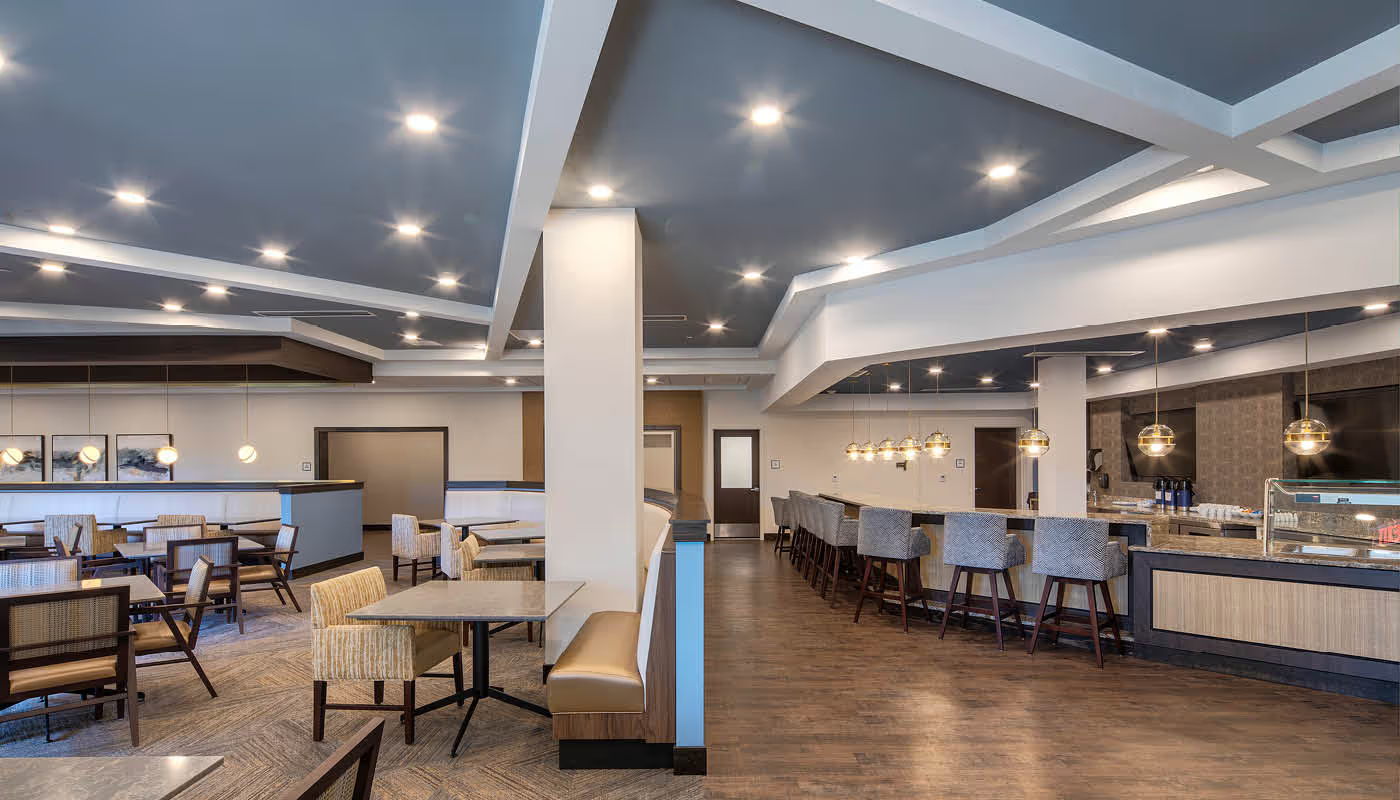
Eagleview Landing
Eagleview Landing combines specialized memory care residences with assisted living apartments in an architecture that adapts to residents' changing health requirements.
The four-story assisted living wing houses 62 apartments, while 45 memory care residences occupy a two-story section. A single main entrance serves both wings, with essential service areas positioned to support both populations efficiently. The design creates distinct living environments for each group while enabling staff to provide seamless care. This approach will expand when two additional independent living buildings join the complex—their interior corridors and common spaces will connect to the current structure, letting residents stay within their established community even as their needs evolve.
Universal Design and Accessibility
Each residence at Eagleview Landing incorporates universal design principles that exceed basic accessibility requirements. In the memory care wing, every apartment features complete accessibility. The assisted living section offers multiple fully accessible layouts among its studio, one-bedroom, and two-bedroom configurations. Generous room dimensions accommodate varied furniture arrangements, giving residents flexibility in creating personal spaces. Private elevated balconies extend select assisted living units, connecting residents to the surrounding landscape.
First Floor Amenities
The assisted living wing's first floor serves multiple purposes through its arrangement of social and activity spaces. Residents move between the theater, multipurpose room, lounges, library, and business center throughout their day. The dining venue divides into distinctive areas—including a private dining room and dedicated bar seating—that provide different dining experiences. Dedicated fitness and wellness rooms support rehabilitation services and physical therapy sessions.

Upper Level Community Spaces
Above the first floor, additional dining and living spaces encourage community interaction. A country kitchen on the second floor brings residents together during meal preparation and service. Sitting rooms positioned at corridor ends invite spontaneous gatherings, while resident laundry rooms add convenience to each floor. The upper levels also house a salon and spa, along with spaces for activities and games. Windows in these common areas frame expansive views of the property's grounds.
Memory Care Environment
In the memory care wing, the floor plan supports resident orientation through a clear circulation pattern. Common spaces branch directly from the main corridor loop, while both floors contain areas for activities, casual gathering, and dining. The kitchen's residential scale encourages resident participation in food preparation. On the second floor, an indoor porch fitted with outdoor-style furniture includes stations for planting activities. The corridors feature life stations that showcase residents' past professions and experiences, creating points of connection and reminiscence.
Interior Design Elements
Interior finishes throughout Eagleview Landing reflect a sophisticated approach to senior living design. The selection of rich colors pairs with bold accent patterns to energize spaces, while varied textures appear in seating, pillows, and surface materials. Light fixtures chosen for each area's function contribute to the upscale, hospitality-inspired atmosphere. The design team selected materials and artwork that balance references to nature with nostalgic elements, creating spaces that feel both fresh and familiar to residents.

Outdoor Living Spaces
Two distinct courtyards extend living spaces outdoors. The memory care courtyard, secured within the building's footprint, combines therapeutic elements: resident planting beds, a fountain, and walking paths with integrated seating. For assisted living residents, a separate courtyard connects ground-floor amenity spaces to the main entry through a covered walkway.
Community Integration
As part of the 800-acre Eagleview Senior Village, the building demonstrates New Urbanist planning principles. The site's natural terraced topography creates distinct zones for outdoor dining and recreation. Residents enjoy views of the adjacent pond and preserved forest areas from many vantage points within the building. LEED standards guided material and system selections, ensuring long-term operational efficiency.












































